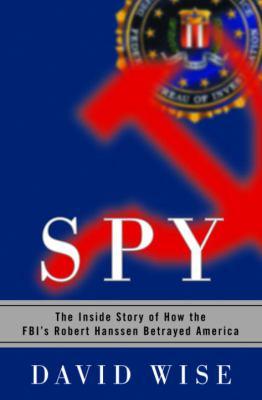
Spy : the inside story of how the FBI's Robert Hanssen betrayed America
Available Copies by Location
| Location | |
|---|---|
| Victoria | Available |
Browse Related Items
- ISBN: 0375507450
-
Physical Description
print
x, 309 pages : illustrations ; 24 cm - Edition 1st ed. --
- Publisher New York : Randon House, [2002]
- Copyright ©2002
Content descriptions
| Bibliography, etc. Note: | Includes bibliographical references and index. |
| Immediate Source of Acquisition Note: | LSC 37.95 |
Additional Information

Spy : The Inside Story of How the FBI's Robert Hanssen Betrayed America
Click an element below to view details:
Excerpt
Spy : The Inside Story of How the FBI's Robert Hanssen Betrayed America
Chapter 1 The Mole Hunter Disaster. Inside the Soviet counterintelligence section at FBI headquarters in Washington, there could be no other word for what had happened: the two KGB agents who were the bureau's highly secret sources inside the Soviet embassy in Washington had somehow been discovered. Valery Martynov and Sergei Motorin had been lured back to Moscow and executed. Each was killed with a bullet in the head, the preferred method used by the KGB to dispatch traitors. There would be no more visits to the candy store by the FBI counterintelligence agents; M&M, as the two KGB men were informally if irreverently known inside FBI headquarters, were gone, two more secret casualties of the Cold War. The year was 1986. The FBI quickly created a six-person team to try to determine what had gone wrong. Meanwhile, the CIA, across the Potomac in Langley, Virginia, was having its own troubles. It was losing dozens of agents inside the Soviet Union, some executed, others thrown into prison. The agency formed a mole hunt group. Two years later, in 1988, the FBI still had no answer to how Martynov, whom the bureau had given the code name pimenta, and Motorin, code name megas, had been lost. Something more had to be done, and the FBI now began thinking the unthinkable. As painful, even heretical, as it might be to consider, perhaps there was a traitor-a Russian spy-inside the FBI itself. To find out the truth was the job of the bureau's intelligence division, which was in charge of arresting spies, penetrating foreign espionage services, and, when possible, recruiting their agents to work for the FBI. The division was divided into sections, one of which, CI-3 (the CI stood for counterintelligence), housed the Soviet analytical unit, the research arm of the bureau's spycatchers. Perhaps, the division's chiefs reasoned, something might be learned if the analysts, looking back to the beginning of the Cold War, carefully studied every report gleaned from a recruitment or a defector that hinted at possible penetrations of the FBI by Soviet intelligence. Perhaps a pattern could be seen that might point to a current penetration, if one existed. Within the Soviet unit, two experienced analysts, Bob King and Jim Milburn, were assigned to read the debriefings of Soviet defectors and reports of Soviet intelligence sources who had, over the years, been recruited as spies by the FBI. The two shared a cubicle in Room 4835 with their supervisor. The supervisor, a tall, forty-four-year-old, somewhat dour man, was not a popular figure among his fellow special agents, although he was respected for his wizardry with computers. He had been born in Chicago, served for a while as a police officer in that city, and joined the FBI twelve years before, in 1976. Now he was responsible for preparing and overseeing the mole study. For the supervisor, directing the analysis to help pinpoint a possible mole inside the FBI was a task of exquisite irony. For he knew who had turned over the names of Valery Martynov and Sergei Motorin to the KGB. He knew there was in fact an active mole inside the FBI, passing the bureau's most highly classified secrets to Moscow. He knew the spy was a trusted counterintelligence agent at headquarters. He knew, in fact, that the spy was a supervisory special agent inside the Soviet analytical unit. He knew all this but could tell no one. And for good reason. Robert Hanssen was looking for himself. Excerpted from Spy: The Inside Story of How the FBI's Robert Hanssen Betrayed America by David Wise All rights reserved by the original copyright owners. Excerpts are provided for display purposes only and may not be reproduced, reprinted or distributed without the written permission of the publisher.


